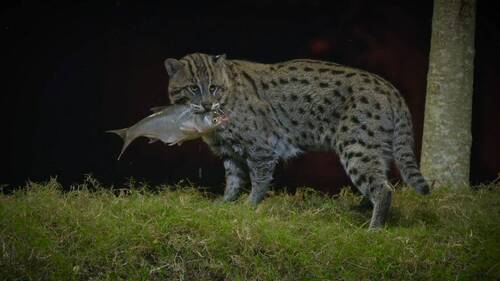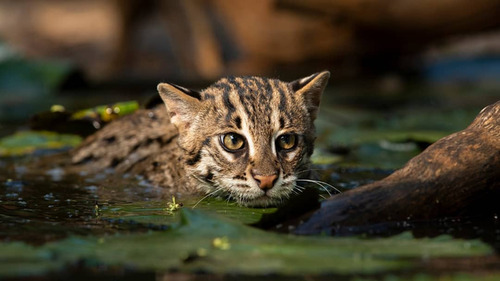Prionailurus viverrinus
IUCN
VUBasic Information
Scientific classification
- name:Prionailurus viverrinus
- Scientific Name:Fishing Cat, Chat Pêcheur,Gato Pescador,Felis viverrina Bennett
- Outline:Carnivora
- Family:P.viverrinus
Vital signs
- length:57-78cm
- Weight:5-16kg
- lifetime:15-20years
Feature
It likes to be active at night and is good at catching fish in the water, hence its name.
Distribution and Habitat
It is mainly distributed in Nepal, India, Myanmar, Thailand and Indonesia. In China, it is only found in Taiwan Province. It lives in shrub areas in forest areas, reed bushes along rivers, and evergreen forests on tropical coasts. It prefers to move around in areas near water.
Appearance
Fishing cats are medium-sized, with an adult length of about 57-78 cm and a weight of 5-16 kg. They have a solid physique and thick hair covering their bodies, which is usually gray-green or brown with black spots and stripes. The fishing cat's hair is not only effective in waterproofing, but also has a short, flat tail.
Details
Fishing cat: one of Asia's most endangered small and medium-sized cats
The fishing cat (Prionailurus viverrinus) is one of Asia's most widespread wild cats, living in wetlands, swamps, and coastal rivers. Fishing cats are famous for their unique fishing skills, however, this small and medium-sized cat is facing a serious threat of extinction. This article will introduce the characteristics of the fishing cat, its habitat, the reasons for its endangerment, and conservation measures to help increase awareness of this species.

Characteristics and living habits of fishing cats
1. Appearance characteristics
Fishing cats are of medium size, with an adult body length of about 57-78 cm and a weight of 5-16 kg. They have a solid physique, with thick hair covering the body, usually gray-green or brown, with black spots and stripes. Fishing cats not only have effective waterproof fur, but their short, flat tails also help them maintain balance in the water.
2. Life habits
Fishing cats are best known for their fishing ability. They are one of the few cats that specialize in catching fish as their main food source. Fishing cats are usually active at night or at dusk, and they are very skilled swimmers, and can even catch prey underwater. In addition to fish, they also prey on frogs, crustaceans, birds, and small mammals.
3. Habitat
Fishing cats are mainly distributed in wetlands, mangroves, swamps, and riverside areas in South Asia and Southeast Asia. Due to their dependence on water sources, their habitats are usually closely related to water bodies. However, with the rapid disappearance of wetlands, the living space of fishing cats is also seriously threatened.
Endangered status and causes of fishing cats
1. Habitat destruction
The most significant extinction risk for fishing cats comes from habitat destruction. Human activities have led to large-scale development of wetlands into agricultural land, urban and industrial areas, and the wetlands, mangroves and swamps on which fishing cats depend for survival are rapidly decreasing. Especially in South Asian countries, climate change has led to frequent floods and river overflows, further reducing the habitat of fishing cats.
2. Illegal hunting and trade
The fur of fishing cats is regarded as a precious item in some areas, leading to illegal hunting. In addition, fishing cats are also threatened by the wildlife trade, and they are illegally captured and sold, further reducing their wild population.
3. Conflict between humans and fishing cats
Fishing cats are often considered a threat to farmland and aquaculture ponds because they prey on crops such as fish and waterfowl, as well as cash animals. Local residents sometimes set traps or directly hunt fishing cats to protect their livelihoods. This conflict between humans and fishing cats further exacerbates their endangered status.
Conservation status and measures for fishing cats
1. International protection level
Fishing cats are listed as "Endangered" by the **International Union for Conservation of Nature (IUCN)** and are listed in Appendix II of the Convention on International Trade in Endangered Species of Wild Fauna and Flora (CITES), prohibiting international trade. Despite this, the conservation status of fishing cats remains a concern, especially in countries where wetland protection is weak.
2. Wetland protection and habitat restoration
As fishing cats are highly dependent on wetlands, protecting and restoring wetlands has become a key measure for their survival. In recent years, some countries have strengthened wetland protection and established wetland nature reserves to provide a relatively safe habitat for fishing cats. However, the limited area of these reserves is still not enough to fully ensure the stability of the fishing cat population.
3. Public awareness and community participation
Raising public awareness of the endangered status of fishing cats is the key to protecting this species. Through publicity and education activities, more people can understand the ecological value of fishing cats and their survival crisis, reducing conflicts with humans. In addition, the participation of local communities in protection is also crucial, encouraging farmers and fishermen to adopt ecologically friendly farming and breeding methods to reduce damage to fishing cat habitats.
4. Scientific Research and Monitoring
Scientists are strengthening population monitoring and ecological research on fishing cats, using GPS tracking technology and monitoring equipment to further understand the range of fishing cats, reproductive behavior, and population dynamics. These data will help to develop more effective conservation strategies.
Fishing cats are one of the most representative and endangered small and medium-sized cats in Asia. Their unique fishing skills make them unique among cats. However, due to habitat loss, illegal hunting, and conflicts between humans and fishing cats, they are facing an unprecedented survival crisis. Protecting fishing cats is not only about protecting a wild animal, but also about maintaining the balance of wetland ecosystems. Through global cooperation and public participation, we still have a chance to save this precious species.

There are several animals that are similar to fishing cats in appearance or living habits. Here are some animals that look like fishing cats:
1. Plains Cat (Prionailurus bengalensis)
Appearance: Similar to the fishing cat, the plains cat also has spotted patterns and gray-brown fur. It is slightly smaller and generally more slender.
Habitat: Found in a variety of habitats across Asia, including forests, grasslands, and farmlands, it feeds primarily on small mammals, but is not as focused on catching fish as the fishing cat.
Similarities: The spotted patterns and wild cat features make the plains cat visually similar to the fishing cat, but the living habits are quite different.
2. Ocelot (Prionailurus bengalensis)
Appearance: Ocelots and fishing cats have similar spotted patterns and gray-yellow or brown fur. They are small in size and their facial structure is similar to that of fishing cats.
Habitat: Ocelots are widely distributed in forests, bushes and swamps in Asia, preying on small mammals, birds and reptiles.
Similarities: Ocelots and fishing cats are similar in size and markings, but they do not rely on water as much as fishing cats do.
3. Lynx (Lynx lynx)
Appearance: The lynx is larger in size and has distinct black tufts on its ears, unlike the fishing cat. However, the lynx's markings and thick fur give it a certain similarity in appearance to the fishing cat.
Habitat: Lynx usually live in forests and mountains in the Northern Hemisphere, preying on rabbits, birds, and small mammals.
Similarities: Although lynxes are not as fond of water as fishing cats, their wild hunting behaviors and survival methods are somewhat similar.
4. Rusty-spotted cat (Prionailurus rubiginosus)
Appearance: The rusty-spotted cat is a very small cat with finer spots than the fishing cat and a reddish-brown coat. They belong to the same genus as the fishing cat, so they have similar body shapes and spotting patterns.
Habitat: The rusty-spotted cat lives in arid areas and forests of the Indian subcontinent, and mainly preys on small animals.
Similarities: Similar to the fishing cat in size and spots, but their habitats and living habits are different.
5. Leopardus tigrinus
Appearance: The South American tiger cat has a similar spotted pattern to the fishing cat, and its fur is usually yellow or gray-brown with black spots. They are small in size and have similar facial structures.
Habitat: Distributed in tropical forests in South America, it mainly preys on birds, rodents and reptiles.
Similarities: The appearance of the South American tiger cat is similar to that of the fishing cat, especially in terms of markings and body shape, but the living environment and geographical location are very different.
Although these animals have similar appearance or ecological habits to the fishing cat, the fishing cat has a place in the world with its unique fishing ability and wetland habitat, and is a very distinctive cat species.
FAQ
What is a fishing cat?
The fishing cat is a medium-sized wild feline with the scientific name Prionailurus viverrinus. It is primarily found in the wetlands and forests of Southeast and South Asia, known for its exceptional swimming and fish-catching skills.What are the physical characteristics of fishing cats?
Fishing cats have a grayish-brown coat with black spots and stripes. Their partially webbed paws are adapted for swimming, and they have short ears and a relatively short tail, which aids in aquatic activities.What do fishing cats eat?
Fishing cats primarily feed on fish but have a diverse diet that includes amphibians, crustaceans, birds, and small mammals. Occasionally, they prey on domestic poultry near water sources.What threats do fishing cats face?
The main threats to fishing cats are habitat loss due to wetland conversion into farmland, urbanization, and human hunting. These factors contribute to the steady decline in their population.What is the conservation status of fishing cats?
Fishing cats are classified as Endangered (EN) by the International Union for Conservation of Nature (IUCN). Conservation efforts are underway to protect their habitats and mitigate human impact.








